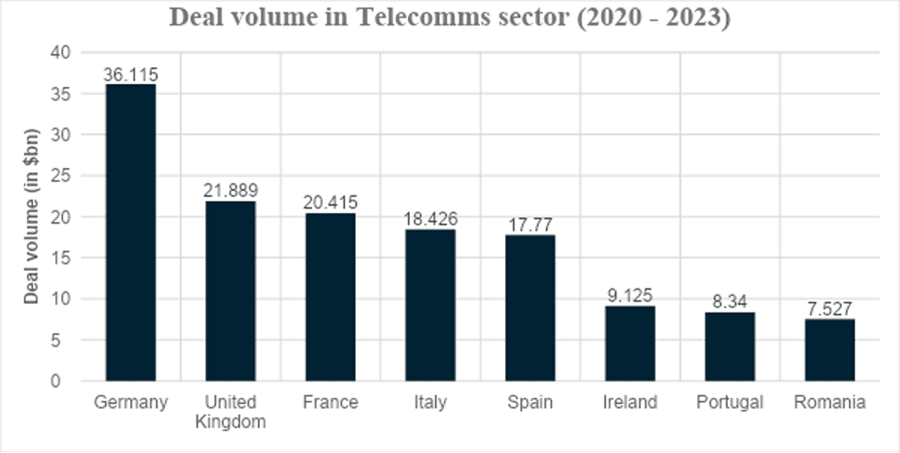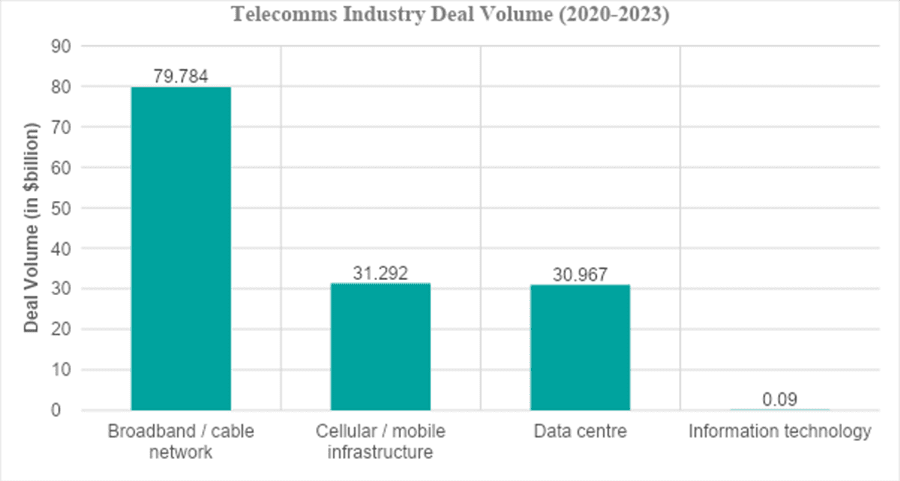Telecom and AI Status in the EU
By Afnan Khan with Ajay Lotan Thakur
Introduction
In the eerie silence of deserted streets and amidst the anxious hum of masked conversations, the world found itself gripped by the rapid proliferation of COVID-19. Soon labelled a global pandemic due to the havoc wreaked by soaring death tolls, it brought unprecedented disruption and accelerated the inevitable rise of the digital age. The era of digital transformation has swiftly transitioned, spawning a multitude of businesses catering to every human need. Today, our dependence on digital technology remains steadfast, with remote work becoming the norm and IT services spending increasing from $1.071 trillion in 2020 to $1.585 trillion. [1]
The chart below, sourced from Oliver Wyman Forum Analysis,[2] vividly illustrates our increasing dependence on technology. It presents findings from a survey conducted in the latter half of 2020 across eight countries – US, UK, France, Germany, Italy, Spain, Singapore, and China. The survey reveals that 60% of respondents favoured increased use of video conferencing, while online grocery shopping and telehealth services each garnered 59% approval, and E-learning showed a strong preference at 56%. This data underscores how swiftly digital solutions integrated into our daily lives during the pandemic.
Source: Olive Wyman Forum Analysis [2]
Advancements in Telecom and AI Applications Across EU
The graph below represents the project and infrastructure finance deal volume in the telecommunications sector from 2020 to 2023. The dominance of Germany is evident, with the deal volume reported to be $36.115 billion, followed by the UK at $21.889 billion. France follows closely in third place with a deal volume of $20.415 billion, representing significant market potential. The only other two countries with substantial figures are Italy and Spain, although there have been some promising deals closing in Ireland, Portugal, and Romania with large new financing deals in the project finance sector.
Source: Proximo Intelligence [5]
Deutsche Telekom, the national provider, has spearheaded advancements with AI-powered network optimisation tools. These tools leverage real-time analytics, resulting in a notable 20% enhancement in network performance and a 15% reduction in customer complaints. [14] While 2022 marked a pivotal year for the industry in Germany, the evolution of German fibre optics infrastructure has continued apace. Germany led Europe’s FTTH (Fibre to the Home) initiative, with significant financings closing throughout the year. According to Proximo Data, 16 European FTTH financings concluded in 2022, amassing nearly $26 billion in deal volume, with German deals accounting for almost $9 billion of that total.
Spain’s Telefónica has deployed an advanced AI-driven fraud detection system that effectively blocks over 95% of fraudulent activities. This initiative not only protects Telefónica from financial losses but also enhances security for its customers. [15] The adoption of AI for cybersecurity underscores a broader trend in the telecom industry towards leveraging advanced technologies to bolster trust and safeguard digital transactions.
Orange has introduced AI-driven chatbots that autonomously handle more than 90% of customer queries in France, resulting in a significant reduction in customer service costs by 40% and a notable increase in customer satisfaction rates by 25%. [16] This innovation represents a paradigm shift in customer service automation within the telecom sector, demonstrating the effectiveness of AI in improving operational efficiency and enhancing the overall customer experience.
Telecom Italia (TIM) has implemented AI-powered network security solutions to proactively detect and mitigate cyber threats in real-time, achieving a remarkable 60% reduction in cybersecurity. [17]
This strategic deployment of AI highlights TIM’s commitment to enhancing network resilience and safeguarding critical infrastructure from evolving cyber threats, setting a precedent for cybersecurity strategies in the telecommunications industry.
Predictive Analysis Enhancing Telecom Resilience
Interference mitigation strategies are essential for smooth digital operations in the post-pandemic world. Picture digital experts rapidly addressing problems from rogue networks and environmental noise, creating a digital shield against disruptions, and ensuring a seamless user experience. These strategies propel telecom companies towards better connectivity and user satisfaction.
These examples highlight the trend of using AI and predictive analytics to boost network performance in cities. As urban areas contend with population growth and increasing digital demands, telecom companies invest in advanced technologies. These reduce network congestion, enhance service reliability, and support sustainable urban development. This trend not only improves customer experience but also positions telecom providers as leaders in developing future smart cities.
The chart below, from the Proximo Intelligence database, shows European deal volumes over the past three years, categorised by sub-sectors. The broadband and cable network sector leads with a deal volume of $79.784 billion from 86 deals out of a total 137 in project and infrastructure finance. Cellular and mobile infrastructure follows with $31.292 billion across 25 deals. Data centres, a growing trend, also report a deal volume of $30.967 billion across 25 deals.
Source: Proximo Intelligence [5]
In the post-COVID era, the adoption of predictive maintenance and real-time monitoring has accelerated, becoming a critical component of the new normal for businesses. These technologies enable companies to build more resilient infrastructures, proactively mitigate risks, and enhance operational efficiency. As businesses continue adapting to a rapidly changing environment, the integration of predictive maintenance solutions plays a pivotal role in sustaining long-term growth and stability.
Europe has seen profound impacts from these advancements, setting a precedent for global telecom strategies moving forward.
Future Trends and The Way Forward
European telecommunications face challenges shaped by regulatory frameworks, economic conditions, and technological advancements:
- Brexit introduces regulatory uncertainties for UK telecoms. [18]
- Germany’s GDPR compliance challenges demand heavy investment. [19]
- Spain faces economic instability affecting telecom investments. [20]
- France’s 5G deployment is delayed by regulatory barriers. [21]
- Italy’s 5G rollout is hindered by spectrum allocation challenges. [22]
- The Netherlands invests in cybersecurity for evolving threats. [23]
- Sweden focuses on bridging rural connectivity gaps. [24]
- Switzerland navigates complex regulatory landscapes for innovation. [25]
In the wake of COVID-19, with masks now a thing of the past and streets deserted only due to construction, digital technologies are transforming European telecommunications amidst regulatory shifts and economic uncertainties. Investments in infrastructure and AI innovations are pivotal, shaping the industry’s future and its adaptation to rapid change while driving economic recovery across Europe. How will the industry sustain innovation and meet growing digital demands ahead? Only time will tell.
References
- https://www.statista.com/statistics/203291/global-it-services-spending-forecast/
- https://www.oliverwyman.com/our-expertise/perspectives/health/2021/mar/why-4-technologies-that-boomed-during-covid-19-will-keep-people-.html
- https://www.worldometers.info/coronavirus/
- https://www.gov.uk/government/news/new-data-shows-small-businesses-received-213-billion-in-covid-19-local-authority-business-support-grants#:~:text=Press%20release-,New%20data%20shows%20small%20businesses%20received%20%C2%A321.3%20billion%20in,and%20arts%2C%20entertainment%20and%20recreation.
- Proximo Intelligence Data: www.proximoinfra.com
- Vodafone Press Release, 2022.
- “McKinsey & Company. “Predictive maintenance: The rise of self-maintaining assets.”
- Deloitte. “Predictive maintenance: Taking proactivity to the next level.”
- Forbes. “Why Virtual Assistants Are Becoming Essential for Businesses.”
- Statista. “Growth in Demand for Virtual Assistants in Europe.”
- TechRadar. “Vodafone’s AI traffic prediction cuts network congestion by 25% in London.”
- The Guardian. “BT/EE’s AI traffic prediction cuts network congestion by 30% in London.”
- FCC (2023). Spectrum Efficiency Report. Federal Communications Commission. Available at: https://www.fcc.gov/reports-research/reports/fcc-research/spectrum-efficiency.
- Deutsche Telekom’s AI-Powered Network Optimization,” TechInsights
- “Telefónica’s AI-Driven Fraud Detection,” TelecomsToday. Available at: TelecomsToday AI Fraud Detection
- “Orange’s AI-Enabled Customer Support,” AI Insider. Available at: AI Insider AI Customer Support
- “TIM’s AI-Powered Cybersecurity Measures,” CyberTechNews. Available at: CyberTechNews AI Cybersecurity
- TelecomsInsight. “Brexit’s Regulatory Impact on UK Telecoms.”
- DataPrivacyToday. “GDPR Compliance Challenges for German Telcos.”
- BusinessWire. “Spain’s Economic Recovery Challenges.”
- TelecomsObserver. “France’s Regulatory Roadblocks to 5G Deployment.”
- SpectrumInsight. “Italy’s Spectrum Allocation Challenges.”
- CyberDefenseMag. “Netherlands’ Cybersecurity Imperatives.”
- DigitalInclusionHub. “Sweden’s Rural Connectivity Initiatives.”
- RegTechInsights. “Switzerland’s Regulatory Adaptation Challenges.”
Afnan Khan is a Machine Learning Engineer specialising in Marketing Analytics, currently working as a Marketing Analyst at the Exile Group in London. He is involved in various projects, research, and roles related to Machine Learning, Data Science, and AI.
Ajay Lotan Thakur is a Senior IEEE Member, IEEE Techblog Editorial Board Member, BCS Fellow, TST Member of ONF’s Open-Source Aether (Private 5G) Project, Cloud Software Architect at Intel Canada.





